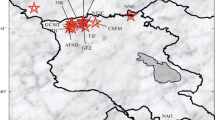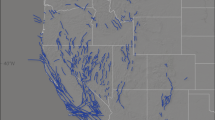Abstract
Earthquake epicenter distributions do not provide any information on the fault strike alone. To determine the correct fault strike considering the epicenter sequences in these distributions, it is necessary to know both the fault mechanism and the focal depths. The mechanism is of crucial importance with the character of the fault zone in question. However, the depth information is a more efficient parameter for such a purpose. Therefore, one of the procedures that must be carried out for a region with known earthquake parameters is the extraction of the depth section. The earthquake hypocentral section is an important subject of Earth sciences and it is very crucial in active tectonics. Unfortunately, these sections have not been extracted very accurately in the studies so far worldwide. The easy and fast extraction of these cross sections, which are produced from the parameters of epicentral distance and focal depth, is possible through carrying out of the extraction of cross sections by means of a computer. The data sizes used today make this indispensable. HYPOSEC is a Fortran 95 computer code produced for this purpose. The design, running principles, and product of this software program are the subject of this study. HYPOSEC is a robust Fortran code list with a size of 345 KB that uses 16 subprograms composed of 2000 lines. Its version in this study is limited to producing the desired cross-section data. Drawing is not included in this version. The preference for drawing belongs to the user. HYPOSEC is based on an interactive and easy-to-use algorithm. It may use not only a data file compatible with the program’s format (TUREQ3.DAT) but also special data files according to the preference by the user. Besides the extraction of a simple hypocentral depth section, HYPOSEC also allows monitoring the rupture process concerning an earthquake. This operation can be performed according to time or space in parallel with user’s preference. In this study, the HYPOSEC software program is used for both the October 23, 2011 (Mw = 7.1) Tabanlı-Van earthquake and the May 24, 2014 (Mw = 6.9) Saros (Northern Aegean Sea) earthquake. For the Van earthquake, it was applied to the aftershocks that occurred within the first 3 months, 6 months, 9 months, 1 year, 1.5 years, and 2 years after the main shock. These data in use belong to the electronic earthquake catalog by Kandilli Observatory and Earthquake Research Institute of Boğaziçi University. A total of 7766 earthquake data were used during these applications. The cross sections of the different strikes selected according to the faulting strike of the earthquake concerned, its rupture surface, and its relationship with the regional tectonism are extracted by means of HYPOSEC and studied comparatively. Accordingly, a seismogenic zone that subducted northward with a slope of about 25° was activated with the process of the Van earthquake. As also for the Saros earthquake, its consecutive cross section defined the fracture mechanism was made. According to this successive cross section, it was seen that progressing of the fracture mechanism after the main shock had performed as more heavy in the footwall.














Similar content being viewed by others
References
Derbentli T (1985) Programming and Fortran 77 (Programlama ve Fortran 77), Kitap Dağıtımcılık (1985), İstanbul, Turkey, 239 p, (in Turkish)
Grapher, Graphing System, Version 5.04.21 January 19, 2005, Golden Software, Inc., 809 14th Street, Golden, Colorado 80401, USA
Gutenberg B, Richter CF (1942) Earthquake magnitude, intensity, energy and acceleration. Bull Seism Soc Am 32:163–191
Kalafat D, Kekovalı K, Güneş Y, Kara M, Deniz P, Yılmazer M (2011) Bütünleştirilmiş Homojen Türkiye Deprem Kataloğu (1900–2010; M≥4.0) [A Revised and extended earthquake catalogue for Turkey since 1900 (M≥4.0)]. Boğaziçi University, Kandilli Observatory and Earthquake Research Institute, Bebek-İstanbul, ISBN 978-975-518-303-9, (in Turkish)
Koeri (Kandilli observatory and earthquake research institute), http://www.koeri.boun.edu.tr, Boğaziçi University, İstanbul, Turkey, October 23, 2011, January 01, 2014
Şaroğlu F, Emre Ö, Kuşçu İ (1992) Active fault map of Turkey. General Directorate of Mineral Research and Exploration. Ankara, Turkey
Tunç M, Parmaksızoğlu C (1999) Fortran 90&95, Beta Basım Yayım Dağıtım A.Ş., ISBN 975-486-755-2, İstanbul, Turkey, 600 p., (in Turkish)
USGS (United States Geological Survey), http://neic.usgs.gov, October 23, November 4, 2011
Utku M (2009) Analysis of Denizli earthquakes according to their activity and cumulative activity terms. Bulletin of the Mineral Research and Exploration 138:7–33
Utku M (2013) A computer code for cross-section relate to earthquake focal depths: KESITHX (Deprem Odak Derinlikleri Kesiti için bir Bilgisayar Yazılımı: KESITHX), 17th Workshop of Active Tectonics Scientists (ATAG-17), abstracts, page 33, 24–25 October 2013, Akdeniz University, Antalya, Turkey, (in Turkish)
Wessel P, Smith WHF (2006) The generic mapping tools (GMT) version 4.1.4 Technical Reference & Cookbook. NOAA/NESDIS
Acknowledgements
The author thanks Kandilli Observatory and Earthquake Research Institute of Boğaziçi University, which keeps the earthquake data open for researchers’ use, and United States Geological Survey (USGS) and Harvard University, which performed the CMT solutions, for their all labor. In addition, he thanks Prof.Dr. Hasan Sözbilir and Dr. Ökmen Sümer that they are scientists of geology for their authentic suggestions.
Author information
Authors and Affiliations
Corresponding author
Additional information
Editorial handling: Lun Li.
Rights and permissions
About this article
Cite this article
Utku, M. HYPOSEC: a new tool to determine the earthquake fracture mechanism and the October 23, 2011 (Mw = 7.1) Van earthquake, Eastern Turkey and May 24, 2014 (Mw = 6.9) Saros (Northern Aegean Sea) earthquake. Arab J Geosci 12, 270 (2019). https://doi.org/10.1007/s12517-019-4432-y
Received:
Accepted:
Published:
DOI: https://doi.org/10.1007/s12517-019-4432-y




